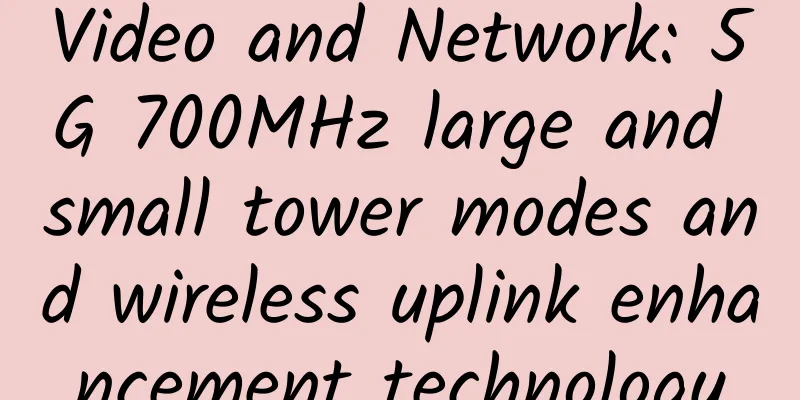Video and Network: 5G 700MHz large and small tower modes and wireless uplink enhancement technology

Labs GuideWith the development of mobile communication technology, the demand for mobile audio and video by radio and television users has grown rapidly. Traditional radio and television technology can no longer meet market demand; organizations around the world have gradually realized that 5G wireless networks will become an important communication channel for radio and television media, and are actively promoting the development of 5G wireless broadcasting technology. The previous article explained why 700MHz is the golden channel, and mainly introduced the concepts and standards related to 5G 700M. This article mainly discusses the key technologies of 5G broadcasting, learning and exploring. This article analyzes and studies the development history of wireless broadcast technology and the solutions of 5G wireless broadcast technology, such as terrestrial broadcast mode, hybrid broadcast mode, and large tower and small tower integration mode. It also introduces several typical principles of wireless uplink enhancement technology, including wireless uplink enhancement technology in the 3GPP standard, dual connection, carrier aggregation, assisted uplink, uplink transmission channel switching, super uplink, and time-frequency dual aggregation technology.
1. Background1.1 Development of wireless broadcasting technology The traditional radio and television industry uses radio and television towers (i.e. large towers, with a coverage range of >100km) to provide one-way broadcast services, using terrestrial broadcast technology; the traditional mobile communications industry uses communication base stations (i.e. small towers) to provide two-way communication services, using unicast technology. These two industries had no intersection before the 3G era. In the 3G era, a variety of mobile multimedia broadcasting technologies have emerged in the radio and television industry. ETSI (European Telecommunications Standards Institute) released the handheld digital video broadcasting technology DVB-H in 2004; 3GPP released the Multimedia Broadcast Multicast Service (MBMS) in Release 6 in 2004, supporting the construction of multicast/broadcast networks in cellular systems; however, these broadcasting technologies have not been integrated with mobile communication technologies, and terminals need to add additional chips or receivers, so they have not been widely used [1]. In the 4G era, 3GPP released the evolved MBMS (eMBMS) technology based on LTE network for the first time in Release 9 in 2009, realizing multicast regional broadcast. In 2017, 3GPP Release 14 released the further evolved multimedia broadcast multicast technology (Forward Enhanced Multimedia Broadcast Multicast Services, FeMBMS), also known as enhanced TV (EnTV), which included large towers in the scope of mobile communication standards for the first time, marking the true integration of mobile communication technology and broadcast technology. In the 5G era, the Release 16 version frozen in July 2020 basically completed the formulation of EnTV standards, including card-free reception, high-speed mobility (120-250km/s), and large coverage (100km between stations). In the ongoing Release 17, standards related to mixed broadcast (Mixed Mode) based on small towers will be formulated to achieve intelligent switching between unicast and multicast/broadcast. In 2019, China Radio and Television (China Radio and Television Network Co., Ltd.) was awarded a 5G commercial license; in 2020, it obtained a license to use the 700MHz (703-733/758-788MHz) frequency band. In 2020, China Radio and Television proposed a 2×30/40MHz technical proposal for 700MHz at the 3GPP Release 16 meeting, which was adopted, expanding the original 2×20MHz to 2×30/40 MHz, becoming the world's first 5G low-frequency band (Sub-1GHz) large-bandwidth international standard. At the same time, China Radio and Television actively promotes the support of small tower-based hybrid broadcast (Mixed Mode) and 5G multicast services in Release 17. 5G multicast services will add network elements and architectures that support multicast/broadcast on the basis of existing 5G network capabilities. 1.2 China Radio and Television and China Mobile jointly build and share In May 2020, China Radio and Television Corporation and China Mobile signed a 5G co-construction and sharing cooperation framework agreement, which clearly stated that the two sides would co-build and share 700MHz 5G wireless network resources, and China Mobile would share 2.6GHz and 3G/4G/5G networks for a fee. The agreement achieved complementary advantages between the two parties. Radio and Television Corporation reduced the pressure of building 5G from scratch and is expected to realize 5G wireless broadcasting technology; Mobile can achieve low-cost continuous coverage and uplink enhancement in remote areas of 5G, reducing costs and increasing efficiency. In January 2021, China Mobile and China Radio and Television Corporation signed a series of specific cooperation agreements, fully communicating and reaching consensus on specific issues such as construction, maintenance, market and settlement. 1.3 China Radio and Television 700MHz Spectrum Planning In addition to 700M, the Ministry of Industry and Information Technology authorized the 4.9 GHz frequency band to China Radio and Television in January 2020. Since the 5G broadcast channel plan has not yet been announced, based on the existing spectrum requirements, the China Academy of Radio and Television Science has proposed three division strategies (as shown in Table 1). Table 1 China Radio and Television’s 5G spectrum allocation strategy
2. 5G Broadcast TechnologyThe broadcast technology currently used in 5G (before Release 17) generally refers to the 4G LTE broadcast technology that has evolved from 3GPP Release 9 to the present. Based on the requirements of different scenarios for broadcast technology, 5G broadcast technology includes two solutions: terrestrial broadcast mode and hybrid broadcast mode (as shown in Figure 1). Figure 1 5G broadcast technology solution 2.1 Terrestrial broadcasting mode Terrestrial Mode is also called tower broadcasting, which uses a broadcasting mode based on high power high tower (HPHT). It is suitable for pushing live TV programs with wide coverage on dedicated spectrum. Based on EnTV, terrestrial broadcasting has only downlink and only supports broadcasting, which is suitable for large and static transmission areas. EnTV uses the common network elements of LTE data services and adds three new network elements: BMSC, MBMS GW, and MCE to support FeMBMS services. The technical system architecture is shown in Figure 2. BMSC (Broadcast Multicast Service Center) is responsible for providing functions such as user management, session transmission, service declaration, security management and content synchronization. For content providers, BMSC is the entry point for MBMS service content distribution; for the bearer network, BMSC is responsible for authorization, initiating broadcast/multicast services, scheduling, and transmitting content. MBMS GW (MBMS Gateway) is responsible for handling MBMS service distribution and control, and consists of control plane and user plane functions. The control plane processes the session control signaling of MBMS services through MME (Mobility Management Entity) and transmits MBMS session control signaling (Session start/stop) to the base station. The user plane transmits data to the base station in the form of IP multicast streams through broadcast/multicast. MCE (Multi-cell/multicast Coordination Entity) is responsible for allocating time and frequency domain resources for eMBMS and determining the coding and modulation methods of the wireless channel. MCE can be an independent entity or implemented as a logical entity in the base station. In terms of networking methods, it can support both the Multicast Broadcast Single Frequency Network (MBSFN) networking method, which enables multiple cells to form a larger single frequency network; it can also support the Single Cell-Point to Multipoint (SC-PTM) networking method, which broadcasts in a single cell. EnTV technology is based on the 4G LTE core network and has not yet been connected to 5GC, nor is it supported by terminal chips. It is still unknown how it will be implemented in the 5G network of radio and television in the future. 2.2 Hybrid Broadcast Mode Mixed Mode, also known as small tower broadcast, adopts a broadcast mode based on low power small tower (LPLT). Based on 5G NR, the hybrid broadcast mode can dynamically switch between unicast, multicast and broadcast, support uplink and downlink bidirectional data transmission, dynamically configure coverage from a single cell to a large area, and can be multiplexed and seamlessly switched through unicast. In the hybrid mode, available resources are shared by unicast, multicast and broadcast services by using the same physical channel; this resource sharing can be performed in the same subframe (the same concept as SC-PTM in LTE) or in different subframes that allow the use of small-scale SFN deployment (similar to MBSFN), which is conducive to seamless transition between services. Standards related to the hybrid broadcast mode will be developed in 3GPP Release 17. 2.3 Large and small tower integration model High-power large tower broadcasting is the traditional broadcasting method in the radio and television industry. It is characterized by wide coverage, high efficiency, and is suitable for providing public services, but cannot provide interactive services; low-power small towers refer to mobile communication base stations, which have flexible services and can provide personalized, interactive services and high-tech video services, but have a small coverage area and high wide-area coverage costs. The integration of high-power large towers and low-power small towers can provide both single downlink services represented by broadcasting, live broadcasting and emergency communications, as well as two-way services such as on-demand, games, and audio and video. The support capabilities of different transmission methods for services are shown in Table 2. Table 2 Comparison of service capabilities of large and small towers In actual deployment, it is recommended to adopt a network architecture solution with large towers and small towers for joint coverage, as shown in Figure 3. That is, public content and live broadcast services can be broadcast through the broadcast core network and the communication core network EnTV, and personalized content and interactive services can be covered by small towers. 3. Wireless uplink enhancement technology5G networks have a large bandwidth foundation and are supported by technologies such as Massive MIMO and beamforming, which enable the system to have good performance in downlink rate and coverage. However, in the uplink direction, the terminal's transmit power is limited by radiation indicators, and the number of antennas is limited by the terminal's volume, which limits the uplink coverage range and is much smaller than the downlink coverage range. In areas where the uplink cannot be covered, the connection is interrupted and the downlink alone cannot be used. In Release 15, 3GPP introduced a variety of uplink enhancement technologies to solve the uplink coverage problem. 3.1 Dual Connectivity (E-UTRA-NR Dual Connectivity) Technology In order to take into account uplink coverage, in the initial non-standalone networking (NSA) mode of 5G, the networking option 3X is adopted, 4G is responsible for the control plane, and 5G is used as a capacity supplement. 3GPP defined 5G dual connectivity technology (E-UTRA-NR Dual Connectivity, EN-DC) in Release 15 to achieve uplink coverage enhancement. The base station sends information on 4G and 5G simultaneously in downlink, and the capacity is the sum of the two carriers. For the uplink, the terminal uses 1 transmission channel (1Tx) on 4G and 5G to send data. Once the mobile phone moves out of the coverage of 5G, the capacity and coverage of 4G can still be guaranteed. NSA is just a transitional solution, and 5G will eventually take the route of independent deployment (SA). The FR1 spectrum defined by 5G covers the range from 450MHz to 6GHz. In order to solve the uplink coverage problem, some of the FDD low-band spectrum (such as 700MHz) is allocated to 5G, and these low-band and mid-band are combined and deployed as 5G, which will increase the network capacity and uplink coverage. For this low-band and mid-band combination solution, 3GPP also cited two other uplink enhancement technologies in Release 15: 5G Supplementary Uplink (SUL) technology and 5G Carrier Aggregation (CA) technology. 3.2 Carrier Aggregation Technology CA technology was first defined in Release 10 released by 3GPP. It aggregates 2 to 5 component carriers of the same or different frequency bands for use by terminals, improving uplink and downlink transmission rates and solving the resource utilization problem of operators' discontinuous frequency bands. According to the frequency band of the carrier, it is subdivided into intra-band carrier aggregation, i.e. intra-band carrier aggregation (Intra-Band CA) and inter-band carrier aggregation, i.e. inter-band carrier aggregation (Inter-Band CA). CA technology has been maturely commercialized around the world and continues to play a role in the 5G era[7]. In the uplink direction, because two carriers with the same frequency can use the same transmission channel, the uplink rate is significantly improved. As shown in Figure 6, after the two carriers in the 3.5GHz band are aggregated, the uplink rate of a single user is nearly doubled. Out-of-band carrier aggregation is applicable to areas covered by multiple wireless carriers of different frequency bands at the same time, as shown in the left diagram of Figure 7. It not only improves the uplink rate but also improves the coverage range. Area A is covered by both carrier 1 (3.5GHz) and carrier 2 (2.1GHz). Area A can use CA technology to increase the uplink bandwidth, as shown in the right diagram of Figure 7. Area B can only use carrier 2 for uplink communication. It should be noted that due to the different frequency bands, the uplink rate improvement effect will be affected by the carrier bandwidth and uplink duty cycle. 3.3 Supplementary Uplink (SUL) Technology In Release 15, the auxiliary uplink SUL technology is added. In order to ensure the uplink far-point coverage, in addition to configuring the normal medium and high NR frequency bands in the cell, a low-frequency uplink frequency band is added to ensure the uplink far-point coverage. As shown in Figure 8, in the uplink coverage area A (near the midpoint) of the medium and high frequency NR carrier, the medium and high frequency carrier uplink is used for data transmission. Beyond the NR coverage range, the terminal uses the low-frequency carrier uplink for data transmission (far point). The terminal can dynamically select the uplink from the medium and high frequency carriers and the low frequency carriers, but can only select one of the uplink transmission links at the same time. 3.4 Uplink Tx Switching Technology 5G commercial terminals generally support 2 transmission channels (2Tx) in the uplink, and dual-stream transmission in the same frequency band can optimize the bandwidth (double it). In multi-band networking, if the two transmission channels are allocated to different frequency bands for transmission, the spectrum resources cannot be optimally utilized. 3GPP Release 16 introduced the uplink transmission channel switching technology (Uplink Tx Switching, UL Tx switching), which implements a fixed uplink channel carrier 1 (such as 3.5GHz), and the other uplink transmission channel switches between carrier 1 and carrier 2 (2.1GHz): the time period when carrier 1 performs downlink transmission is allocated to carrier 2 for uplink transmission, and the time period when carrier 1 performs uplink transmission is switched to carrier 1, realizing TDD-NR uplink dual-stream transmission in the same frequency band. As shown in Figure 9. Uplink Tx Switching technology can be combined with auxiliary uplink SUL and inter-band carrier aggregation Inter-Band CA technology to further improve the utilization of spectrum resources. The two-network collaboration between China Mobile and Radio and Television mainly adopts these two SUL and inter-band CA solutions based on Uplink Tx Switching. 3.5 Super Uplink (SUL with Uplink Tx Switching) Technology SUL with Uplink Tx Switching, also known as super uplink, is a SUL integrated uplink transmission channel switching technology. With SUL technology, there can only be one uplink transmission link at the same time, and the low-frequency band only provides supplementary uplink coverage at the far end of the cell, but the user experience and latency of users near the midpoint are not improved, as shown in Figure 10, left. SUL with Uplink Tx Switching technology can have two uplink transmission links in the uplink, which can not only enhance the uplink coverage at the far point, but also enhance the uplink capacity at the near midpoint, as shown in Figure 10 right. Neither of them participates in the transmission of downlink data. In the TDD frequency band, uplink and downlink send information at different times. Since the download demand is much greater than the upload demand, the allocation of TDD uplink and downlink time is biased towards the downlink, and the ratio of mainstream uplink time slots, special time slots, and downlink time slots is 2:1:7. In the super uplink solution on the right side of Figure 10, one uplink of the terminal is fixed at 2.6GHz, and the other uplink uses the uplink transmission data of the 700MHz auxiliary carrier (near point 700M orange) in the time period of the 2.6GHz carrier TDD downlink time slot near the midpoint of the cell (near point green); in the time period of the 2.6GHz carrier uplink time slot, the 700MHz auxiliary carrier returns the uplink transmission channel to the 2.6GHz carrier to achieve 2.6GHz TDD-NR dual-stream uplink transmission. Since uplink transmission can be performed at all times near the midpoint, not only the uplink rate is improved, but also the delay of downlink data feedback is reduced, which indirectly improves the downlink rate. At the far point, the area that the 2.6GHz uplink cannot cover, the uplink task is completely handed over to the 700MHz auxiliary carrier (the far point orange). In this solution, 700MHz only enhances the uplink, and the downlink still uses the 2.6GHz frequency band. 3.6 Time-Frequency Dual Aggregation (CA with Uplink Tx Switching) Technology CA with Uplink Tx Switching technology is also called time-frequency dual aggregation. It is a combination of out-of-band carrier aggregation technology and uplink transmission channel switching technology. Inter-Band CA technology uses carrier aggregation for both uplink and downlink in areas covered by both carriers. In the uplink, it is limited by the transmission channel of the terminal, which has a negative impact on capacity in some scenarios. CA with Uplink Tx Switching technology abandons uplink carrier aggregation. Its uplink solution is the same as super uplink. In the uplink time slot of TDD, the terminal can use two transmission channels to transmit data simultaneously, which can maximize the use of spectrum resources. In the downlink, TDD and FDD carrier aggregation is maintained to enhance downlink capacity. As shown in Figure 11. In Release 16, 3GPP enhanced CA and SUL through Uplink Tx Switching technology. Since SUL is a new technology for 5G, the industry chain is not mature enough, and the SUL carrier and NR carrier are tightly coupled, so cross-site and cross-cell deployment is not supported yet, which brings challenges to commercial deployment. CA technology has a high level of industry maturity, supports cross-site and cross-cell deployment, and has test cases for 5G experimental networks. Mainstream terminal chip manufacturers have support plans. Considering the industry chain, network performance (coverage, rate and latency), and deployment complexity, CA technology combined with Uplink Tx Switching is the best uplink enhancement technology. For a comparison of the performance and maturity of various uplink enhancement technologies, see Table 3. Table 3 Comparison of uplink enhancement technologies The above mainly introduces the key technologies of 5G 700MHz, including the development history of wireless broadcast technology and solutions of 5G wireless broadcast technology, such as terrestrial broadcast mode, hybrid broadcast mode, and large tower and small tower integration mode; at the same time, several typical principles of wireless uplink enhancement technology are introduced, including wireless uplink enhancement technology in 3GPP standards, dual connection, carrier aggregation, auxiliary uplink, uplink transmission channel switching, super uplink, and time-frequency dual aggregation technology. References [1] 5G Broadcasting and Television System Technology and Planning Research Report (2020 Edition). [2] 3GPP, TS 23.246, Multimedia Broadcast/Multicast Service (MBMS); Architecture and functional description, V16.1, Sep. 24th, 2019. [3] 3GPP, TS 36.300, Evolved Universal Terrestrial Radio Access (E-UTRA) and Evolved Universal Terrestrial Radio Access Network (E-UTRAN); Overall description; Stage 2, V16.4, Dec. 2020. [4] 3GPP, TS 36.976, Evolved Universal Terrestrial Radio Access (E-UTRA) and Evolved Universal Terrestrial Radio Access Network (E-UTRAN); Overall description; Stage 2, V16.0, Mar. 2020. [5] ETSI, TS 103 720, 5G Broadcast System for linear TV and radio services;LTE-based 5G terrestrial broadcast system, V1.1.1, Dec. 2020. [6] 2020 World 5G Conference, “5G Broadcast Technology Solution” White Paper, V7.0 P, Nov. 2020. [7] ZTE - 5G Uplink Enhancement Technology White Paper, 2020. Source: Originally adapted based on the research of Migu TSG Lighthouse Team, Li Lin [This article is an original article by 51CTO columnist "Mobile Labs". Please contact the original author for reprinting.] Click here to read more articles by this author |
<<: 5G private network is a big watermelon (Part 2): The mystery of the collision
>>: Cloud dedicated line and customer access technology networking solutions
Recommend
5G applications are gaining attention, adding new impetus to smart education!
Education is a national priority. my country has ...
In the era of instant messaging, what else can 5G bring us besides speed?
The 5G era is approaching, bringing more poetic i...
Don’t understand TCP three-way handshake and four-way wave? Interviewer: Go back and wait for notification!
🌟 Opening: You think you know TCP? Actually... Co...
ABC in the eyes of communication professionals...
[[375451]] As a communications engineer, I am exp...
Interpretation of the "Three-Year Special Action Plan for Improving IPv6 Traffic (2021-2023)"
The large-scale deployment and application of IPv...
How to identify fiber link problems?
Methods for Identifying Fiber Link Problems There...
IT maintenance: Five aspects of daily switch maintenance, all practical information!
With the rapid development of informatization, sw...
Chinese companies are strong in 5G R&D, spectrum strategy planning needs to be implemented
In recent times, 5G has become popular in the cir...
DMIT: Hong Kong CN2 GIA line $298.8/year-2GB/40G SSD/500GB@300Mbps/optional quarterly payment
DMIT.io is a foreign hosting company founded in 2...
Understand how 5G base stations and 4G base stations work together in one article?
A few days ago, a netizen left a message asking h...
How can enterprises fully leverage the potential of private 5G networks?
It may take some time for 5G to become the most a...
How practical is 5G for ordinary people?
5G has three main advantages over 4G: high speed,...
Faced with slowing growth, operators need to change their roles
The past year was the "golden period" f...
Will the next 5G data package be an “unlimited data package”?
In the past two years, 4G unlimited data packages...
Remote holographic presentation is the development direction in the 5G era, and AR/VR hardware has entered a period of quantitative change
"Holographic telepresence is expected to bec...









